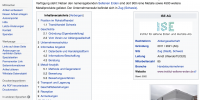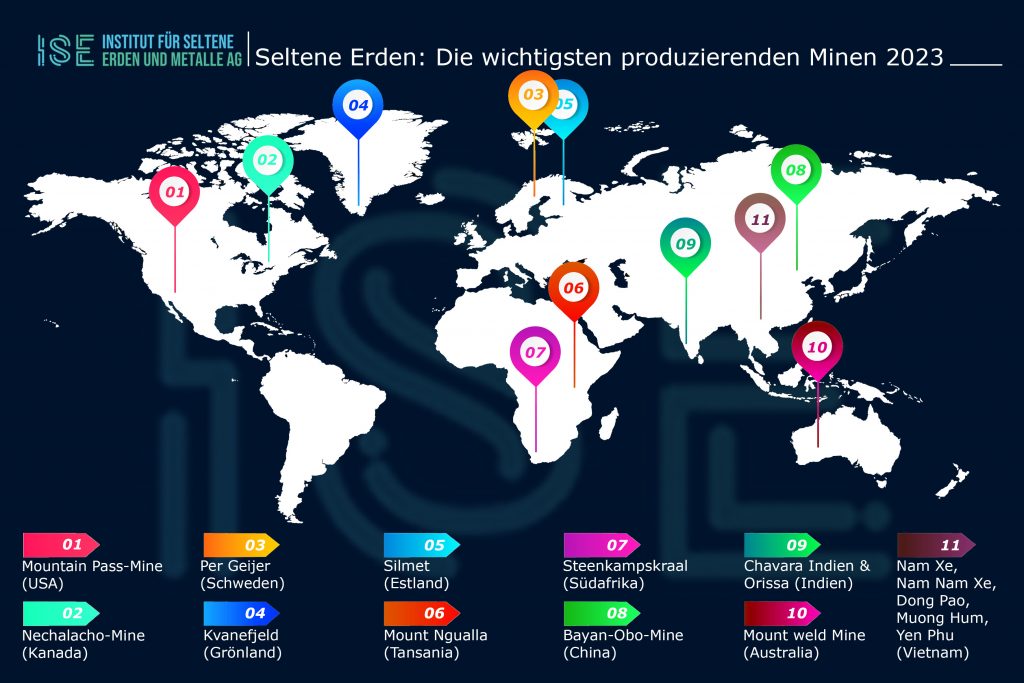New refrigerator technology, Tesla, e-mobility and alternative energies need heavy rare earths
Interview with Helmut Weimer, Emuro GmbHBE: Mr. Weimer, how has the situation with the rare earths developed in the last 12 months? Did the market find its way? Weimer: Due to the global economic downturn, we felt a decline in demand. The resulting price consolidation and the immense black exports, especially in the heavy rare earths, but have now found their bottom. The draconian penalties for black exports and the Chinese government's build up of strategic reserves (according to AsianMetal, noteworthy quantities of terbium oxide, as well as neodymium, gadolinium, dysprosium and praseodymium) have contributed.BE: Has the demand been moved within the rare earths?
Weimer: Our previous recommendations, ie the investment in the heavy rare earths, remain unchanged. Heavy rare earths are mainly used in "green technologies" (electromobility, wind turbines, energy-saving lamps). Until the opening of at least one of the 20 known deposits with heavy rare earths outside of China, the supply situation with these rare earths is still endangered.
In the meantime, General Electric has developed a new generation of highly efficient refrigerators.http://www.ingenieur.de/Themen/Ene… ). This new technology is based on a series of magnets and will soon replace established technologies used in refrigeration technology. Best results have been achieved with magnets based on a gadolinium-containing alloy. This could significantly increase the global demand for gadolinium and subsequently raise the price of this metal. Therefore, we now also assess gadolinium oxide within the heavy rare earths as a promising investment metal.
BE: To what extent has demand changed by substitutes? According to Spiegel, global demand should have shrunk by one third (http://www.manager-magazin.de/finanzen/a… Which rare earths or substitutes are they?
Weimer: I can not agree with the statement of the mirror in this form. On the one hand, we have always warned against investing in Rare Earth Certificates and also had a cautious stance on rare earth exploration stocks.
A shrinking of the global demand for rare earths amounting to about 33%, caused by substitution, is not entirely correct. In phosphors, for example, a substitution of rare earths is not possible at all. What has changed is, for example, the quantitative requirement of individual rare earths. In the case of the phosphors, for example, a shift from the energy-saving lamp to the LED has taken place faster than expected. As a result, less yttrium and europium will be required in LED production in the future.
For wind turbines also existing, but associated with disadvantages technical possibilities without the use of permanent magnets can be used. Substitution of rare earth-containing permanent magnets in e-mobility is currently only possible to a very limited extent.
Individual producers tried to switch to alternatives due to the price peaks. Unfortunately, this was at the expense of “performance” and has now reversed itself.
BE: Does Tesla's Gigafactory also have an impact on rare earths?
Weimer: First of all, one should assume or assume that the gigafactory of Tesla can be realized on this scale at all. There are currently a lot of uncertainties, which include, above all, a reliable supply of raw materials and the not yet secured financing in the amount of approximately 5 billion USD.
The new “Gigafactory” would drive up lithium consumption in particular. Lithium mining is already interfering with "hitherto largely untouched ecosystems in China and South America," as a study by the Fraunhofer Institute for Systems and Innovation Research (ISI) found. Other metals could also cause problems if Tesla increases its annual production from currently around 22.500 cars to around 500.000 units as planned. E-cars require considerably more metallic raw materials such as copper, lithium and rare earths than conventional cars.
BE: How do you assess the WTO decision in favor of the industrialized countries regarding China's rare earth policy?
Weimer: The impact of the WTO ruling will be rather small. On the one hand, China has appealed and on the other, the Chinese have begun to increase their own strategic reserves. The state-run China Securities Journal wrote on 9.April 2014 that between the State Bureau of Material Reserve (SBMR) and some major producers of rare earths (China Minmetal Rare Earth, Inner Mongolia Batou Steel Rare Earth, Ganzhou Rae Earth, etc. ) an agreement on reserves has been signed. It is said that over 13.000 tons of additional rare earths are added to the strategic reserves of China. According to AsianMetal remarkable amounts of terbium oxide, but also neodymium, gadolinium, dysprosium and praseodymium are stored.
Based on the volume of (national) Chinese reserves, the major producers of rare earths will be forced to increase their own reserves by about 30%. Market participants are therefore expected to see rare earth prices increase in China in the next few weeks as government reserves increase.
Of course, China will also use the issue of pollution or pollution in the WTO decision. The introduction of fiscal measures in this polluting sector has officially started. China's intention to introduce a new rare earth environmental tax from 2015 will, according to market experts, also tend to increase prices.
BE: What has become of the almost 300 companies that took advantage of the moment a few years ago to raise funds for exploration on the capital market?
Weimer: In the recent past, reports on more than 400 potential deposits for rare earths aroused the desire that these would lead to a considerable relief of the market and a relaxation of Chinese supplies. We had and still have a firm opinion on this: of the more than 400 deposits, perhaps around fifty will be able to complete their exploration, provided they are provided with the necessary equity capital in the future. Hoping for significant borrowing in the current phase is rather unlikely. The institutional investors have completely said goodbye to mine financing. Only private investors still take part in financing rounds that are processed by the exploration companies via "private placements".
There will be two or three companies in the real production phase, perhaps five in the long run, but the high investment in exploration, the conveyors, and the extremely high costs of the separation plants (Lynas is now more than 1,3 billion Australian dollars) an indication that these projects may never be funded.
BE: How are the two major SE Explorers Lynas and Molycorp developing?
Weimer: The two companies usually produce the light rare earths, which are dirt cheap. What the companies need are high proportions of the more expensive and sought-after rare earths, which can only be found in traces in the deposits. And so the entire financing of the deposits does not fit at all. So when Lynas and Molycorp go into full production, they will flood the market for the light rare earths, the prices of these earths will fall, and the other newcomers will have the earth burned. China will be able to continue to exercise its power, especially with regard to the strategically more important heavy rare earths. I do not see any relief in the market through a large new range of heavy rare earths.
The repeated references to the production potentials of Lynas and Molycorp (USA) - that is, to the deposits in Australia and the USA that are not dependent on China - are on weak feet. Lynas does not get going in its ultra-modern processing plant in Malaysia because environmental groups are constantly shooting across the board. For the first six months to the end of last year, Lynas reported a loss of A $ 59,29 million, and additional financing is expected to be required for the repayment of loans and the planned expansion of production in the next twelve months.
And Molycorp? Well, if they ever reach the ever-revised targets (which will require further major capital increases), they will almost exclusively produce light rare earths such as cerium, lanthanum, and hope for this heavily strained society due to the specifications of the Mountain Pass deposit also a lot of neodymium, which is indeed sought in the market for permanent magnets. Of the very popular heavy rare earths, they promote hardly any significant amounts. With pure number games, so with the Tonnagesumme all rare earths one may not analyze these, but one must concentrate on the values and quantities of the individual rare earth metals. The hoped-for new production volumes of Lynas and Molycorp will not be any relief for the heavy rare earths.
BE: A Japanese mining company has signed an exploration agreement with Jamaica. Does Jamaica really have such large deposits whose mining could move the market?
Weimer: Nippon Light Metal Holdings, Japan, has entered into a joint venture agreement with the Jamaican government with 2013 to reduce approximately 1.500 tonnes of rare earths in the future. It is not yet known what rare earths are or how the deposit is put together in detail and what the development costs look like. Whether this planned mining, if it is realized, can move the market, I dare to doubt.
BE: What's up in the Spiegel story, according to which Germany wants to mine rare earth minerals in the deep sea (http://article.wn.com/view/2014/… )? Is this still going to happen or is it more of a Jules Verne story a la a journey to the center of the earth?
Weimer: Current deep-sea research raises many questions. Above all, the ecological aspects are then hardly serious to judge. From a technical point of view, selective exploitation on the seabed is possible today, but science is not yet well prepared for the deep sea. For the rare earths, deepwater reservoir development is overly costly and involves the risk that accurate exploration is not very reliable.
The decisive economic reference project from the point of view of the scientists works off Papua New Guinea in the Pacific. The Canadian multi “Nautilus Minerals” wants to mine manganese nodules there. Gold, silver, copper and zinc are said to be located in an area 1,3 kilometers long and up to 200 meters wide. At the moment, however, work in the Bismarcksee has been stopped due to a legal dispute with the government. The background to this is the Convention on the Law of the Sea since 1982, which regulates the economic use of marine mining within the countries. And therein lies additional fuel for the future.
BE: What is the customer interest in rare earths?
Weimer: Customer interest has increased again for a few weeks. We found that many customers who had invested at higher prices in 2011, used the current price level for “cost reductions”. In addition to the heavy rare earths, this also applies to the special metal gallium, so we are looking to the future with great optimism.
BE: What is the best way for an investor? Purchase via bonded warehouse or storage at home?
Weimer: When storing, it is important to note a few points in advance. Above all, it is important that the stored goods, whether rare earths or special metals, are in original packaging and in tradeable industrial bundles of the respective manufacturers. In addition, the associated chemical analysis of the corresponding rare earth oxides or special metals is absolutely necessary to ensure a later resale to the industry easily.
The storage in the duty-free warehouse of course saves the investor VAT and customs against storage at home. In addition, the logistical effort for a sale from the bonded warehouse is much lower than for a sale from a private deposit.
BE: Mr. Weimer, thank you for the interview.
The interview was conducted by Christoph Rohrmoser
Source: http://www.boerse-express.com/pagesfoonds/31113





